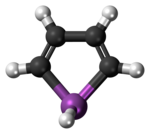Stibole is a theoretical heterocyclic organic compound, a five-membered ring with the formula C4H4SbH. It is classified as a metallole. It can be viewed as a structural analog of pyrrole, with antimony replacing the nitrogen atom of pyrrole. Substituted derivatives, which have been synthesized, are called stiboles.
| |||
| Names | |||
|---|---|---|---|
| Preferred IUPAC name
1H-Stibole | |||
| Identifiers | |||
3D model (JSmol)
|
|||
| ChemSpider | |||
PubChem CID
|
|||
CompTox Dashboard (EPA)
|
|||
| |||
| |||
| Properties | |||
| C4H5Sb | |||
| Molar mass | 174.844 g·mol−1 | ||
| Related compounds | |||
Related compounds
|
Pyrrole, phosphole, arsole, bismole | ||
Except where otherwise noted, data are given for materials in their standard state (at 25 °C [77 °F], 100 kPa).
| |||
Reactions
edit2,5-Dimethyl-1-phenyl-1H-stibole, for example, can be formed by the reaction of 1,1-dibutyl-2,5-dimethylstannole and dichlorophenylstibine.[1] Stiboles can be used to form ferrocene-like sandwich compounds.[2]
See also
editReferences
edit- ^ J.I.G. Cadogan; S.V. Ley; G. Pattenden; R.A. Raphael; C.W. Rees, eds. (1996), Dictionary of Organic Compounds, vol. 3 (6 ed.), Chapman & Hall, p. 2710, ISBN 978-0-412-54090-5, retrieved 2010-03-04
- ^ A.R. Katritzky; Otto Meth-Cohn; C.W. Rees, eds. (1995), Comprehensive Organic Functional Group Transformations, vol. 4, Elsevier, pp. 1038–1040, ISBN 978-0-08-042325-8, retrieved 2010-03-04

